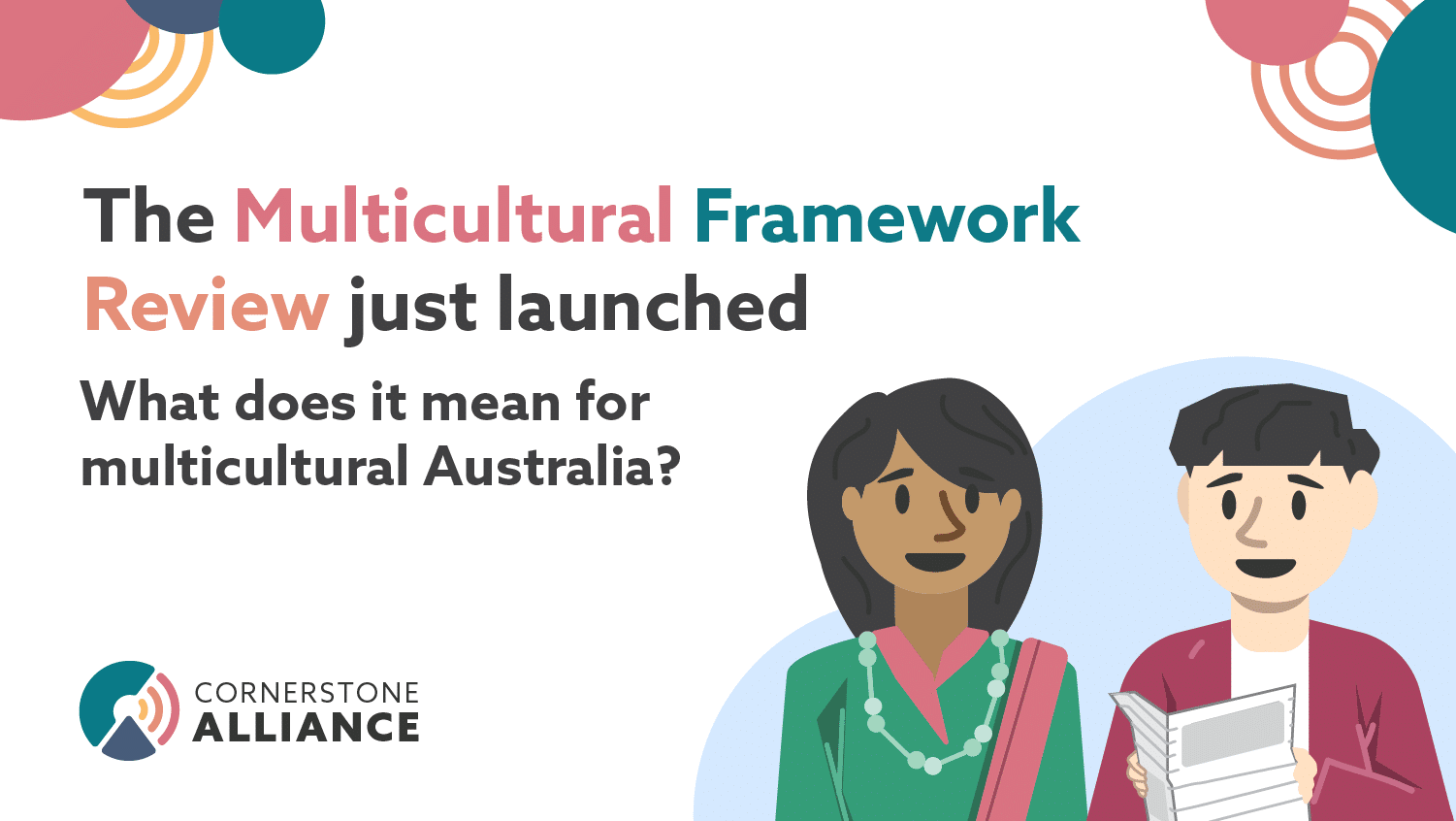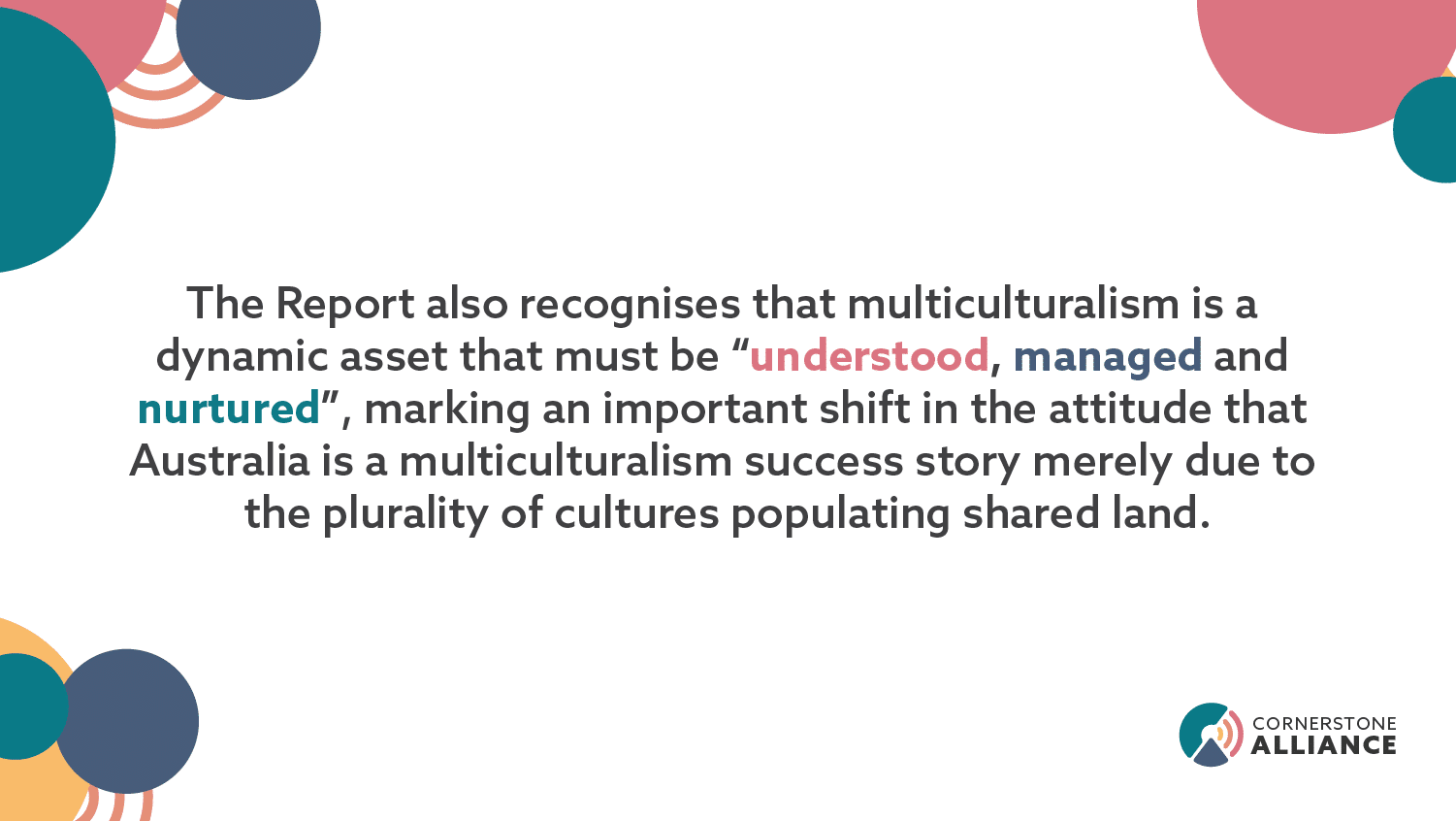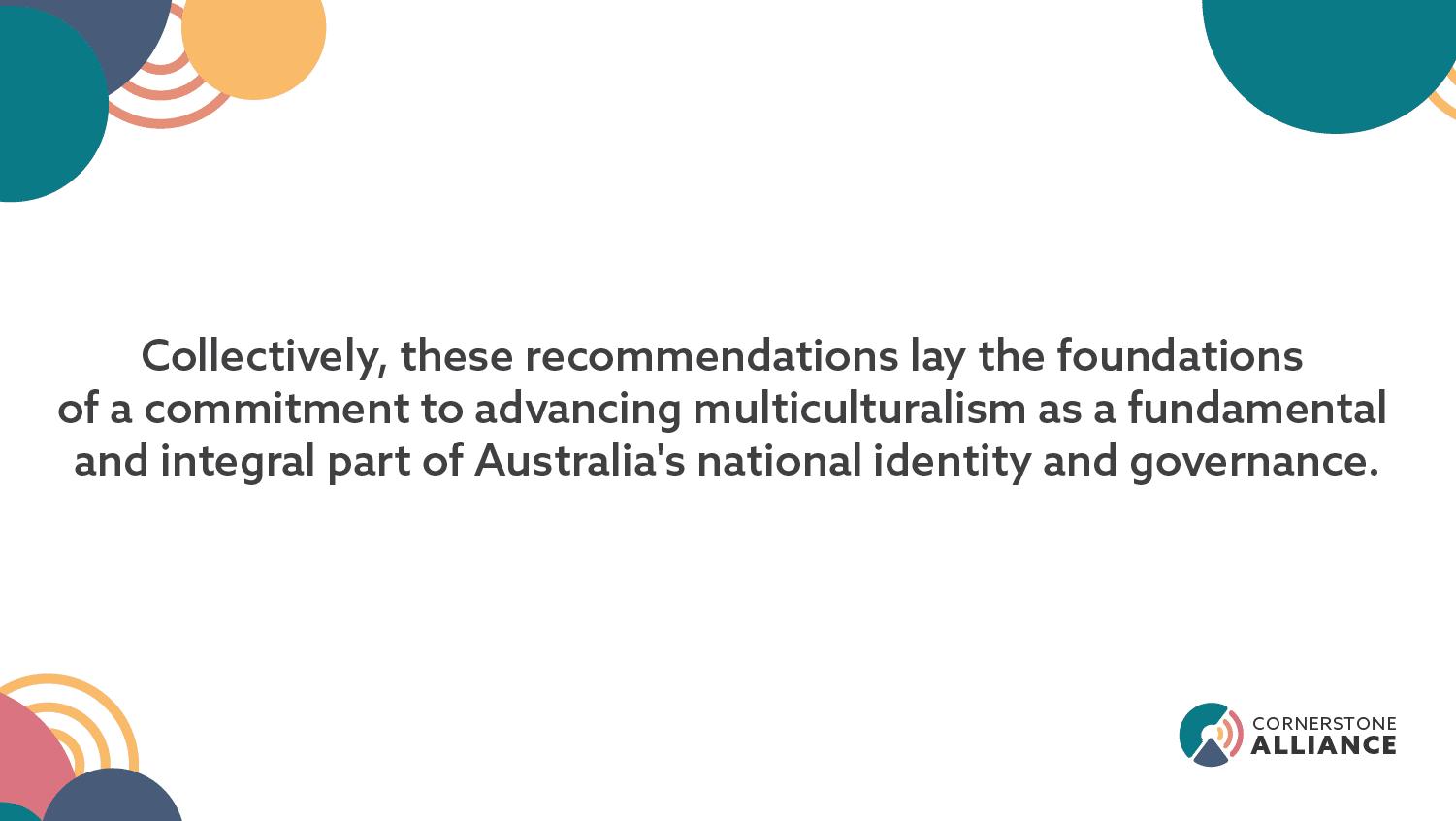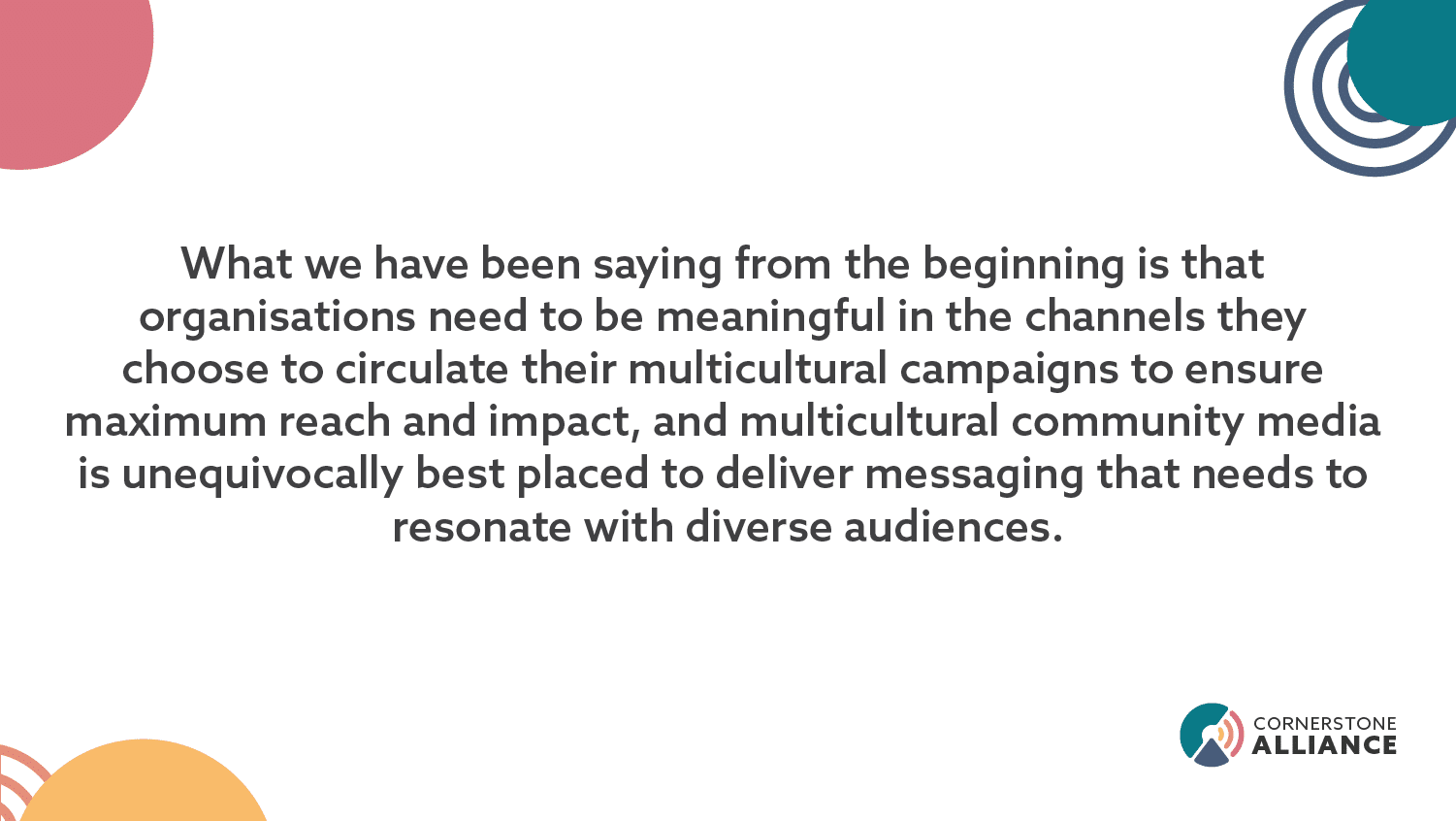By Samoda Silva.
On the 24th of July 2024, the then Minister for Immigration, Citizenship and Multicultural Affairs of Australia, Andrew Giles MP, launched the final report of the Multicultural Framework Review.
What is the Multicultural Framework Review?
The Review was launched in August 2023 by the Minister and proposed a comprehensive assessment of Australia’s current multicultural framework inclusive of institutional arrangements, legislative and policy settings. The Terms of Reference indicated a broad scope for the Review, with some calling it a “once-in-a-generation” examination of the state of multiculturalism in Australia. The last time this country tackled multiculturalism with such depth and purpose was in 1973 upon the tabling of the Whitlam government’s paper quite literally hard launching the concept of multiculturalism to a nation freshly weaned off the White Australia policy.
The Review was led by a panel of three eminent Australians, Dr Bulent Hass Dellal AO, Nyadol Nyuon OAM and Christine Castley, as well as a Reference Group that provided advice and support to the Panel. Over six months, the Review Panel travelled the length and breadth of the nation, facilitating public consultations with over 1,500 people from over 750 unique organisations and groups, and welcomed 796 submissions from agencies and individuals to influence the Report.
In an Australian first, a multilingual submission platform was developed to both inform individuals and organisations of the Review and its scope in 35 different community languages, and receive and translate submissions in real-time. 15% of all submissions received ultimately were submitted in a language other than English. The Review also accepted submissions in a variety of mediums, including video, audio, documents or written text, and even an art competition for children, some submissions of which are featured in the Report itself.
It is undeniable that organisations cannot engage in public consultation about a better multicultural Australia without a submission process that is accessible to the individuals and communities with whom they need to engage and whom the Review directly affects. This principle is also consistent with that detailed in the Report, where an inability to speak English well or at all should not be seen as a deficit or barrier to people who migrate to Australia or stem from different language backgrounds (p. 75).
Read more about the thinking behind the submissions platform here.
What did the Multicultural Framework Review find?
The Review sets out 29 recommendations to further multiculturalism in a new era of Australian consciousness, with 10 “high-priority” items that the Panel views as “immediately actionable”. The recommendations are a self-described “necessarily ambitious” framework that honours multiculturalism as an Australian value beyond a mere policy area, and a national conversation well overdue.
What’s apparent upon first read of the Report is the sheer breadth of processes, services initiatives and sectors that the Review findings, but more broadly, multiculturalism, touches upon, from volunteerism and sports to legal justice and health outcomes. The Report also recognises that multiculturalism is a dynamic asset that must be “understood, managed and nurtured”, marking an important shift in the attitude that Australia is a multiculturalism success story merely due to the plurality of cultures populating shared land.
The submissions to the panel identified over 60 themes, ranging from inclusion and belonging to discrimination and racism to education, visas, and recognition of cultural activities and events. These themes underscore the three overarching core principles presented in the roadmap: “Connection,” “Identity and Belonging,” and “Inclusion.”
There are some real ambitious recommendations in there: the establishment of a Multicultural Affairs Commission and Commissioner, a standalone Department and Minister of Multicultural Affairs, Immigration and Citizenship, a revitalised national language policy and a comprehensive review into multicultural capability within the Australian public service. Collectively, these recommendations lay the foundations of a commitment to advancing multiculturalism as a fundamental and integral part of Australia’s national identity and governance. Whether they will be implemented by the Australian government is a different story. Dr Dellal admitted on RN Breakfast that there are some recommendations the government will never implement, like Recommendation 3. This regards changes to citizenship test procedures to provide the test in languages other than English. This revelation exposes the humbling reality of political limitations to government action, a hard truth to swallow with the opportunity this Review sows for powerful change.
On a different note, it is refreshing to see a formal policy document touch upon the unique, intrinsic complexities of multiculturalism in a manner not just limited to economic, social, and political implications. Chapter 1 highlights the multifaceted, ever-evolving look and feel of multiculturalism in Australia, involving some challenging conversations about self-identity and identity politics, social inclusion, intersectionality, belonging and national identity. It is an intellectually stimulating exercise to read this document, but arguably, an even more stimulating exercise to navigate these internal discussions within one’s own mind as a multicultural Australian in a multicultural Australia that has yet to fully realise the potential of its tapestry.
Of particular importance to this sector are the following three recommendations:
Recommendation 5: Ensure a formalised and expanded role for SBS, ABC and Community Broadcasting Association of Australia (CBAA)
The Report findings reflect upon the importance of accurate and positive multicultural representation in mainstream media as a key contributor to an individual’s sense of belonging (p. 48). The Report recognises the role that SBS and the ABC play in this pursuit with their standing as national broadcasters focused on inclusive media and representation, and particularly SBS considering its position as a provider of multicultural and multilingual media content. Moreover, CBAA, as the peak body for all community broadcasters, represents a critical sector alternative to mainstream broadcasters that speaks to 25% of the Australian population (p. 53). The report recommends that these institutions be bestowed formal advisory roles to the federal government to improve outcomes for policy development and service delivery, as well as drive a culture of authentic inclusion and representation in the domestic and international media scene (p. 56).
Recommendation 6: Improve access to government funding for independent multicultural media
Independent Multicultural Media Australia estimates that up to 5 million people consume independent multicultural media, including print and digital newspapers, radio and television. These independent outlets are not publicly funded and are not eligible for grant funding, despite having to compete in a media market against resourced mainstream entities (p. 56). The Review recommends improving access to grants specific to multicultural media platforms, diversifying its funding beyond that currently provided by state/federal governments and multicultural program-related grants (p. 56).
A closer working relationship between the Australian government and mainstream and community media for multicultural Australians has the potential to systemically enhance the way in which the government uses and funds public broadcasting and independent media outlets, contributing to a sustainable landscape for Australia’s cosmopolitan media consumers.
Recommendation 7: Use more diverse sources for government advertising for multicultural campaigns
The Report recommends that the government employ more diverse sources for government advertising for multicultural campaigns in procurement processes to ensure that messaging is directed to independent multicultural media outlets, not just the largest private sector firms.
This is huge.
Within the pandemic era lies an avoidable number of examples where important messaging directed towards multicultural communities from the federal government was disseminated using “foreign-owned digital businesses such as Google and Facebook” (p. 51), in contrast to engaging independent Australian multicultural media outlets. Finite resources were expended on translating media releases and public relations, where they could have been spent on tying national campaigns with community media for the best practical outcomes whilst also bolstering already underfunded media outlets during a financially challenging period for many organisations. Looking back, we fully recognise the impact that a lack of clear and effective communication had on already vulnerable multicultural communities during the pandemic, with communities experiencing heightened confusion, misinformation and isolation. The failure to leverage independent multicultural press from the get-go meant that critical health information and guidelines did not reach all segments of the population in an accessible and culturally sensitive manner, and in a manner suited to address already existing inequities facing multicultural communities regarding access to information, understanding of recommendations and mistrust of authority.
What we have been saying from the beginning is that organisations need to be meaningful in the channels they choose to circulate their multicultural campaigns to ensure maximum reach and impact, and multicultural community media is unequivocally best placed to deliver messaging that needs to resonate with diverse audiences. By working closely with existing platforms trusted by multicultural Australians, messaging can be tailored to the unique cultural contexts and languages of diverse communities, ensuring that communications are not only received, but acted upon. Independent multicultural media are a unique, rare gem in the competitive media landscape that have the ability to cut through and address gaps left by mainstream media that they simply cannot fill. Involving multicultural media in communication strategies is not just a tactical choice; it’s a must.
The Multicultural Framework Review affirms the idea that multiculturalism has and will always be woven into the fabric of Australia, whether it is entrenched in policy, legislation and institutions or not. Australia is arguably at a “crossroads” in terms of how it approaches its commitment to multiculturalism going forward. However, multiculturalism is an enduring notion, and its presence and persistence of multiculturalism through changes in government leadership, policy and collective attitudes will undeniably continue and retain its integral place within the nation’s societal framework.
The federal government has endorsed the principles of the Report and committed $100 million over the next four years to strengthen multicultural Australia through “investment in language services [and] support for increased community engagement” and resourcing for multicultural organisations to improve their amenities. Significant action is expected if the Australian government is to capitalise on the momentum of this review and deliver on their agenda of fostering a successful and prosperous multicultural nation for a new era of Australia.
Cornerstone Alliance is a multicultural marketing, communications and engagement agency that is committed to representing the right to information by diverse communities. We specialise in the development, design and implementation of multicultural communications, and involve the community in our work. Our other agency easyread.tech specialises in the development of Easy Read and Plain English resources for people with cognitive disabilities and those with low literacy.





